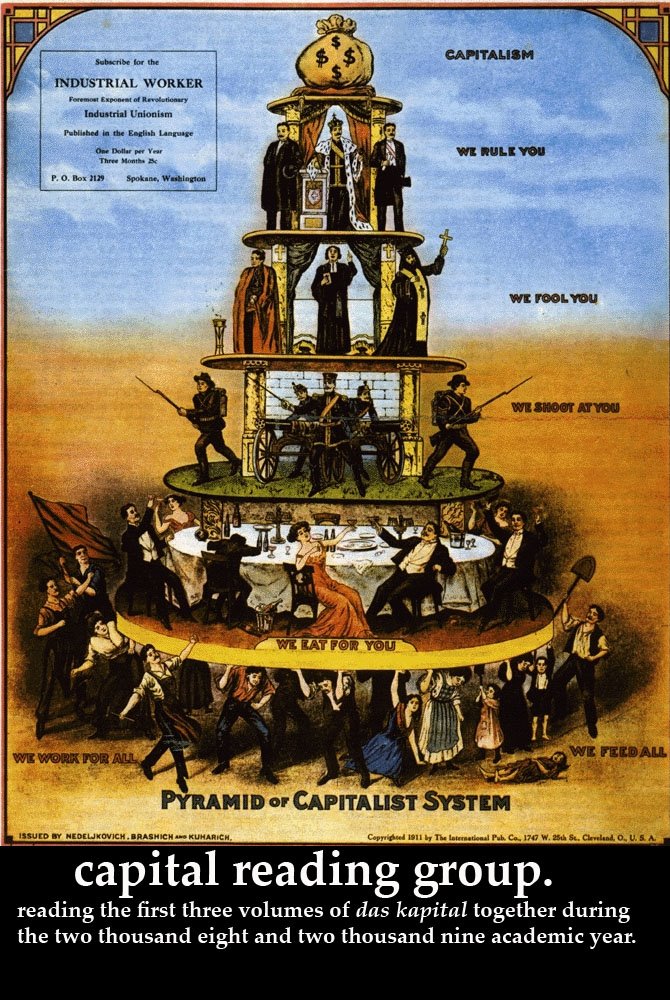Andy has already posted an extensive analysis/summary of these chapters, which I understand to be:
Chapter Four:
Question posed – what is the difference between the simple (and complex) exchange of commodities and the unique logic/process of capital?
Answer – C-M-C’s reflux is back to a commodity that is then consumed (i.e., use-value) outside of circulation while M-C-M’s reflux is back to its originary form, yet with an increase in value that is then re-circulated. In other words, the introduction of ‘surplus value’ and the set up for the next chapter’s problematic.
Chapter Five:
Question posed: how is it that value appears to valorize itself in exchange?
Answer: “The value of a commodity is expressed in its price before it enters into circulation, and it is therefore a pre-condition of circulation, not its result” (260) – and thus – “something must take place in the background which is not visible in the circulation itself. (268)” – Enter the production process and the categories of "labour" (socially-necessary labour/time) and surplus value.
Chapter Six:
Question posed: How is value valorized in production, which is then expressed in (and thus the precondition for) exchange?
Answer: the gap between payment for labour-power (with subsistence as the floor) and the amount of value that accrues in the final commodity – the differential being ‘surplus value’ and thus the ‘source’ of value valorized.
Within these chapters, however, there are interesting aspects that link up to themes discussed in earlier postings - for instance:
1) Marx continually argues that this is a self-perpetuating system of valuation: although the class-struggle is a systemic effect (and yet, also, the condition of possibility for the development and perpetuation of valorization), this is not a process driven by the subjective decisions of a particular class (i.e. the bourgeoisie). On p. 254 he uses the German Träger to describe that the capitalist is the “‘conscious bearer’ of this movement” – and that although a component of this is a “subjective purpose” it is not driven by some anthropological disposition of homo economicus, but that the system of valuation is the subject (said in so many words on the next page where Marx writes: “value here is the subject”; p. 255). Thus at the level of appearance (the social), “value suddenly presents itself as a self-moving substance which passes through a process of its own, and for which commodities and money are both mere forms” and later value “therefore now becomes value in process, money in process, and, as such, capital. (256)”
2) There are multiple temporalities – many of which are non-linear and often times anticipatory (or reversed?) – that operate at different levels of capital, linking up to logics that we have already seen in his analysis of Marx’s commodity form. Here are just a few examples:
- Historical conditions – although the mediation between man and nature is (transhistorically expressed) in labour, “labour”, as a category within capitalism’s logic, is not natural derived. A certain historical development is necessary – namely that capital and labor need to meet in the market: there needs to be a pool of ‘labor’ – people ‘free’ to sell their labor as a commodity and ‘free’ from any other means of subsistence except selling their labor-power, and those with means of production that need to be set in motion (p. 273). In this regard, it might be interesting to test Althusser’s distinction posted before – are the historical conditions (in his word, the historical mechanism) for capitalism and its internal temporalities of capital as a constituted social formation, analytically separable (in Althusser’s term – in their “disjointed unity”)? We might want to return to this question when we get to the question of primitive accumulation and its perpetuation as capital’s reproduction.
- At the level of general process: C-M-C vs. M-C-M – whereby M-C-M forms an endless chain of valorization cycles; C-M-C always ends in the consumption of use-value (even with purchase and expenditure of labour-power by dead-labor [aka capital]), but with M-C-M – “the movement of capital is therefore limitless. (253)”
- When introducing the production process, Marx writes “the value of a commodity is expressed in its price before it enters into circulation, and it is therefore a pre-condition of circulation, not its result. (260)” What appears to be the valorization of a commodity in exchange is merely the expression of what was already anticipated in production. Similar to the dialectic of use-value and exchange-value that comprises the commodity-form, “Capital cannot therefore arise from circulation, and it is equally impossible for it to arise apart from circulation. It must have its origin both in circulation and not in circulation. (268)” For the philosophers out there, what is the logic of this argument?
- While it is necessary for capital to consider the time necessary for sale and the time necessary for production, this latter anticipation contains labour-time which is ‘sold’ to capital on credit – labour’s labour-power (use-value) is expended during the work-week and yet is only paid by contract at the end of the week.
That's it for now….onto Chapter Seven
July 22, 2008
Subscribe to:
Post Comments (Atom)

No comments:
Post a Comment